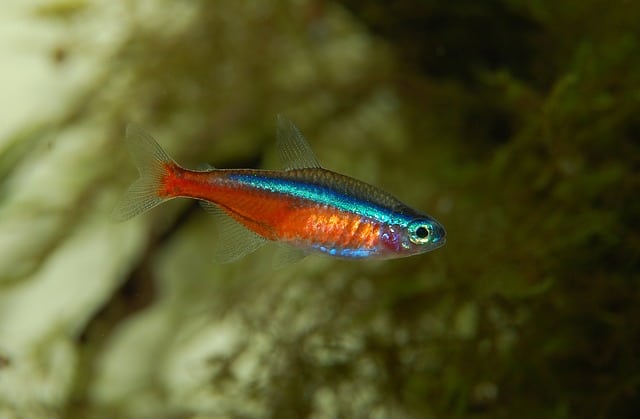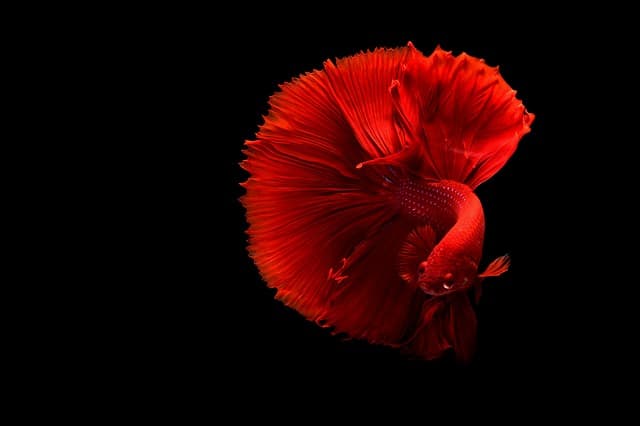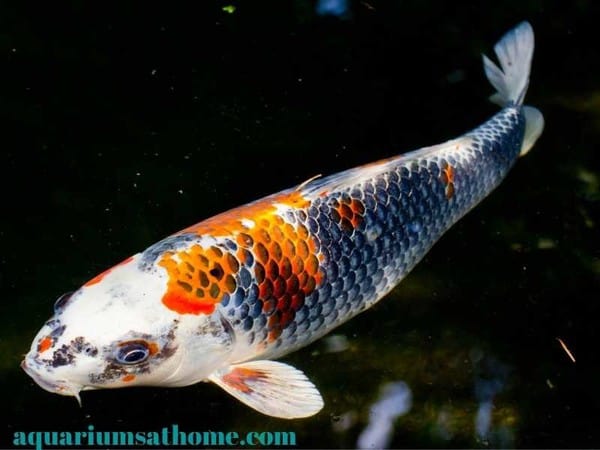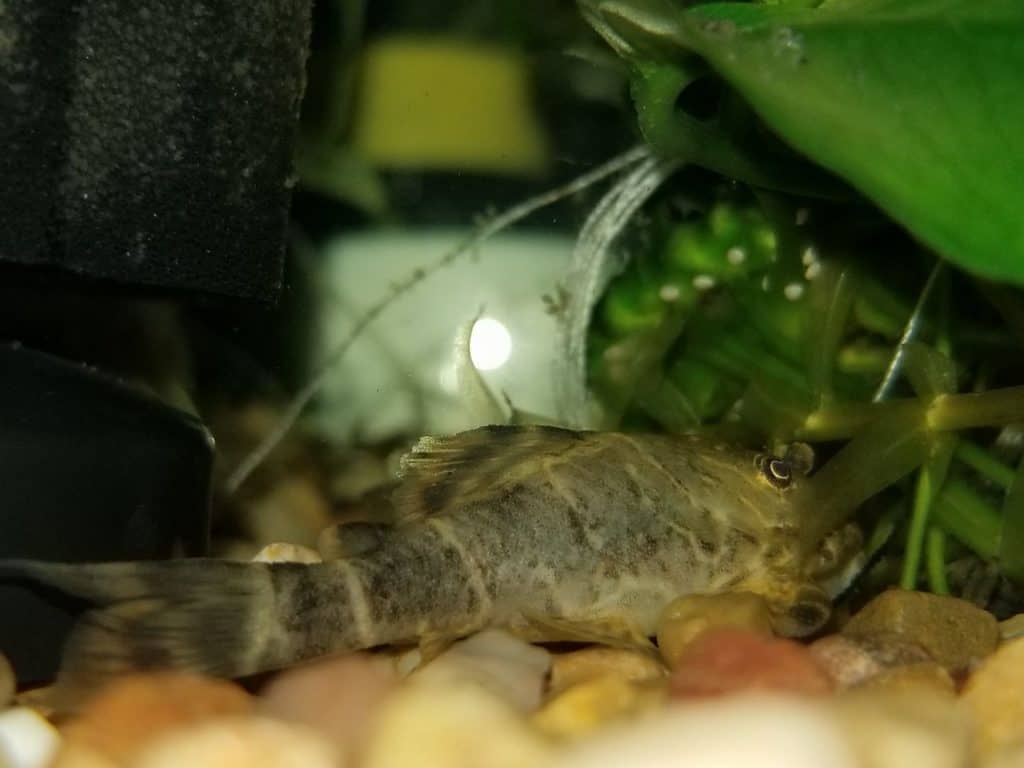The ghost catfish is an interesting and unique looking fish. They are native to rivers in Thailand but can now be found in many pet and fish stores across North America and all over the world.
Ghost Catfish require a lot of care and attention when they first come home with you from the store or breeder. The more time you spend getting your tank set-up for them, the easier it will be to take care of them as they grow into adulthood.
Overview
The ghost catfish is commonly found in aquariums and pet stores and has become a common fish in the aquarium hobby over the past 20 years. There is a similar fish called the glass catfish or kryptopterus bicirris which is larger than the ghost catfish.
The ghost or glass catfish we are talking about in this article is mainly found in pet and fish stores throughout the world and its proper name is kryptopterus vitreolus.
We can use the name ghost or glass catfish interchangeably in this article because the one you find in your store will be of the vitreolus variety.
As previously mentioned, the ghost catfish is a great addition for intermediate aquarists as well as newbies to the hobby that fully invest in learning and caring for their pet fish. If you are a fish owner that wants the easiest fish to care for, then the ghost catfish might not be for you.
The ghost catfish is easily identifiable as you can see right through the fish. Seeing as the fish is clear or transparent, it is in a sense camouflaged since any colors behind the fish on the other side of a predator make it harder for that predator to locate the fish.
Behaviour (Temperament)
If you ever wanted a fish that was extremely peaceful and keeps to itself, then you are in the right place. Ghost catfish are calm and peaceful and almost never bother other fish. While this is great for tankmates, it can work against the catfish in that being peaceful sometimes attracts bullies.
For this reason, having a small school of ghost catfish will help them be happier in your tank. If you have just one or two catfish in an aquarium, you might find them to be timid and always lurking in hiding places.
When you have a school, there is a much better chance the ghost catfish will swim more freely throughout the tank.
Appearance
The ghost catfish is a very interesting-looking fish with a transparent body – unlike most other fish. Its body is not as vibrant in color, giving them a unique ghostly appearance.
The ghost catfish has a long and slender look to it with the head being bent near the front of the body, as opposed to straight like other catfish.
Its backside and fins are darkly marked while the rest of its body is transparent from head to tail. They also have short whisker-like barbels around their mouth.
Ghost catfish can grow up to 5” long. Most of the ones you will find in your local fish store will be somewhere around 2” to 3” long.
Lifespan
While it is reported that the ghost catfish can survive up to 7 to 8 years, you must be realistic. Most aquarium hobbyists will not be able to keep them alive much longer than 5. The only way to ensure the longest life possible is to limit the introduction of new fish and to maintain the proper water parameters.
If you keep your catfish in a school and replace them when others die, then you will keep the existing fish feeling happy and safe. This too can lead to a longer lifespan.
Habitat and Tank Conditions
Here is the section most important in keeping a healthy school of ghost catfish alive for as long as possible.
In their natural habitat, the ghost catfish can be found swimming in rivers and streams. They tend to stay away from strong currents so keep that in mind when setting up their tank.
A planted tank with moderate filtration and some open space is a great place to start. You do not need to have live plants, however, they are a great idea for most freshwater fish tanks.
When I say moderate filtration, I should clarify. Having a filter that is sufficient for the tank size is good enough. Having an oversized filter will lead to heavier water circulation and with the ghost catfish, you want to keep the flow to a minimum.
That said, using a powerhead in a ghost fish tank is not recommended, provided the filtration is large enough to circulate the water thoroughly.
The water parameters in your ghost fish aquarium should be as follows.
- Temperature should be in the range of 75 Fahrenheit to 80 Fahrenheit (23.5 Celsius – 26.5 Celsius)
- The pH of the freshwater should be in the range of 6.5 to 7. Average tap water pH will depend on where you live. You should test your tap waters pH regularly, so you know what you are working with.
- The average tap waters pH in North America is somewhere in the range of 6.5 to 8. It is extremely important to know what pH your fish require and what you are providing for them.
- If the pH is not in the right range, you can purchase water conditioners that will adjust it for you.
As briefly explained already, a planted tank is ideal for ghost fish. Having a moderate quantity of plants in the tank is fine, just make sure to provide lots of open space for the fish to swim. They like to be out in the open and have plants nearby to retreat to if they get scared.
Regarding having plants and hiding places, consider that the ghost catfish has barbels that can get caught on something. Make sure there is enough open space for them to swim freely and safely.
Size of Aquarium
As ghost catfish are schooling fish, so you must account for a school of fish when selecting what size tank to put them in.
I would recommend having at least 5 ghost catfish together. You can have more if you want. I would say that 5 is the least amount you would want in your tank.
Using the traditional method for deciding on the size of fish tank by calculating how many inches of fish you have, if you had 5 ghost catfish that were approximately 2” to 3” in length you would need a tank over 15-gallons.
That just does not seem large enough to me. I would not have 5 ghost catfish in anything smaller than 20-gallon tank, if they were alone with no other tankmates.
There is much debate about the size of fish tanks required for different fish and the amounts of fish you have. Bio-load will always determine if you need a larger tank or if the tank requires more frequent maintenance such as water changes etc.
After all that, the minimum size tank for a small school of catfish should be at least 20-gallons.
Bigger is always going to be better for your pet fish. If you can afford to run a larger tank, then do that. Fish will always appreciate more space to live in.
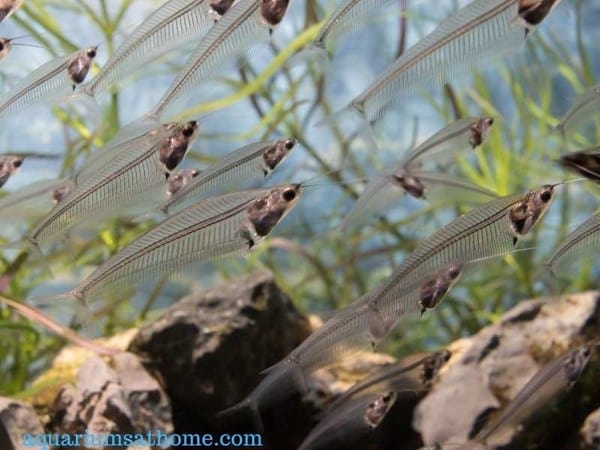
Common Ghost (Glass) Catfish Diseases
Luckily, there are no diseases specific to the common ghost catfish. They are not impervious to disease, however, just like all other aquarium fish, the common diseases that affect the ghost catfish often result from improper care.
Poor water conditions and poor food can cause the ghost catfish to develop diseases such as freshwater ich and columnaris disease. These problems are easily avoided by following these simple steps:
Perform regular maintenance on your fish tank at least once every week or two (or more depending on how fast ammonia builds up in the tank).
- Keep temperatures relatively consistent at minimum 75-degrees Fahrenheit (23.5Celcius).
- Feed your fish only high-quality flakes or pellets designed for tropical fish.
Tank mates
Tank mates for the ghost catfish will be other small tropical fish that do well in community tanks.
These include, but are not limited too:
- neon tetras
- cory catfish
- guppies
- mollies
- zebra danios
- kuhli loaches
- plecos
- platies
- cherry barbs
- swordtails
- killifish
There is a list of friendly non-fin-nipping fish for you that I could think of off the top of my head!
If you are adding ghost catfish to an established tank, make sure you add a whole school at one time. The fish will be less likely to be bullied by doing it this way.
If you want to know which fish are fin nippers, check out this article.
Feeding
Ghost catfish are omnivores. This means they must eat both plants and meat. Feeding these fish a variety of foods will ensure they have a long and healthy life.
Flakes, frozen and freeze-dried foods are all okay, just make sure you are feeding them plant based and animal-based foods as well. Brine shrimp, bloodworms, tubifex worms and tropical fish flakes will make up most of their diet.
Breeding
Breeding ghost catfish is a fun challenge and can be done by just about anyone, if you follow my suggestions below.
Since ghost catfish mostly breed in the wild during the rainy season, you will want to make your fish feel like that is the season they are in. Here are four things you must do to have success breeding ghost catfish.
- The water temperature should be lowered slightly under the recommended lowest tank temperature for ghost catfish which is 75 Fahrenheit. Lower the tank’s temp to at least 73 Fahrenheit. By doing this, you are mimicking the effect of rain accumulating in the river which would lower the temperature of the water. That is number one.
- The next most important thing you can do is add fresh treated tap water to the tank daily as the new influx of cooler water and minerals from the water will mimic rainfall. You might have to swap a bit of water out of the tank which is fine. That is number two. 10% of the tank water being switched out should be enough.
- The next thing to ensure is you must be feeding the fish fresh live food while you are wanting them to breed. There is a lot of activity with bugs and larvae in the rainy season in the wild. Make sure you have 4 to 5 days worth of live food on hand. A week is even better. That is number three.
- Number four is to ensure the female ghost catfish has somewhere to lay the eggs. The female catfish will lay eggs in more than one location so make sure you know where the eggs are.
- You should keep an eye on them as they will hatch in approximately 3 to 4 days. At that point, you will want to catch the fry and place them in a different tank or a fry net to ensure they do not get eaten by any of the grown fish.
Before we are done with the breeding section, we need to talk a bit about identifying male and female ghost catfish. Otherwise, having a tank with just males or females is not going to work.
You can best identify female ghost catfish when there is a large group of them. It is much easier to do this usually when you are looking at them at the fish store. Here is how…
Female ghost catfish will have a slight belly compared to males. It is not always easy to spot unless, you have quite a few swimming together. This larger belly allows the female to carry eggs. You can also tell by the size of the fish. If you have a group of ghost catfish that look to be the same age and there are a couple that are obviously larger, then those are likely females.
It is that simple to identify a female ghost catfish.
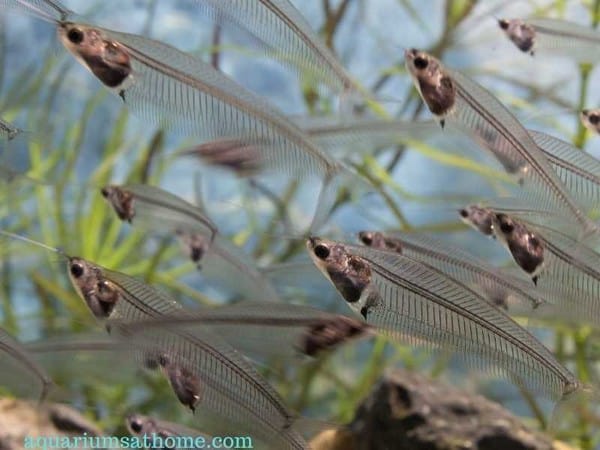
Conclusion
Your glass catfish needs at least a 5-gallon tank with plenty of hiding spots that have plants growing on top for shade (provides protection against too much light).
Ghost glass catfish are beautiful, but not exactly the most well-known type of fish. They are also a little more difficult to care for than other types of freshwater fish. But do not worry! This article will provide you with everything that you need to know to properly care for your ghost glass catfish and make sure they live a long, healthy life.
Good luck!
Related Posts
Bumblebee Catfish Care Guide, Tank Setup & More
Pictus Catfish Care and Tank Setup (Tank Mates, Breeding, Behaviour)
How to Set -up a Brackish Water Aquarium?
Are Mollies Good Starter Fish?
How do You Breed Black Ghost Knife Fish?



